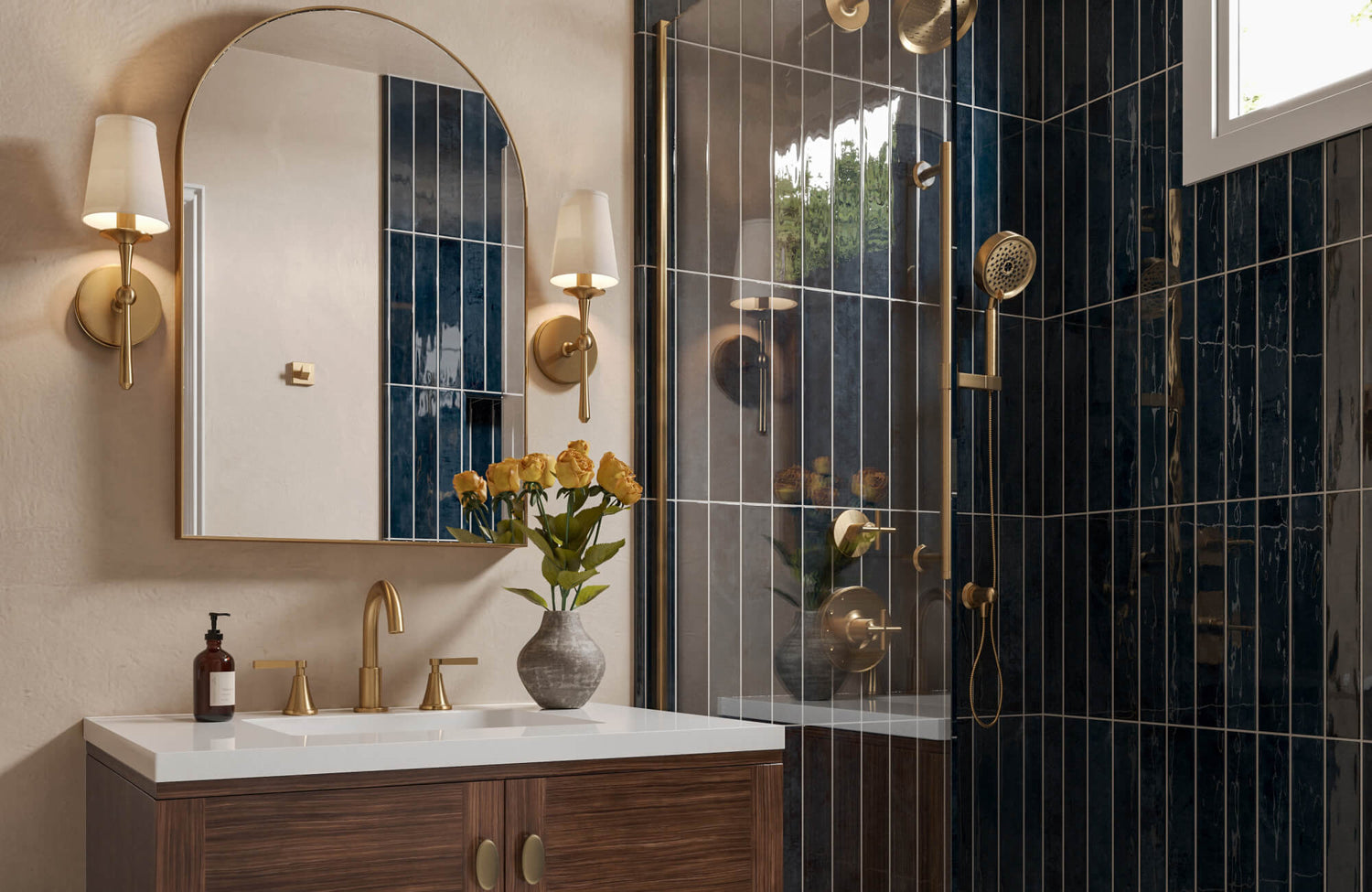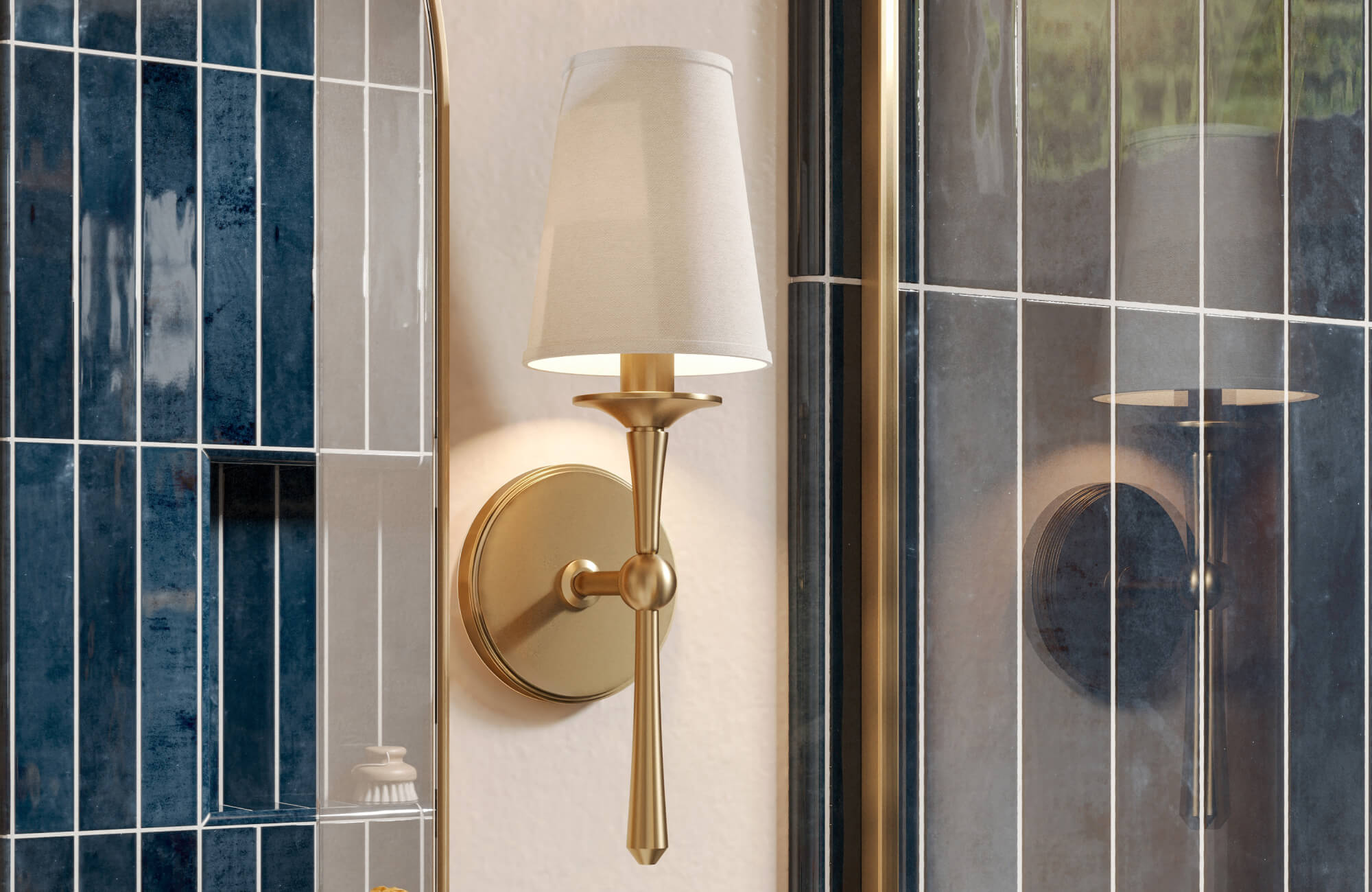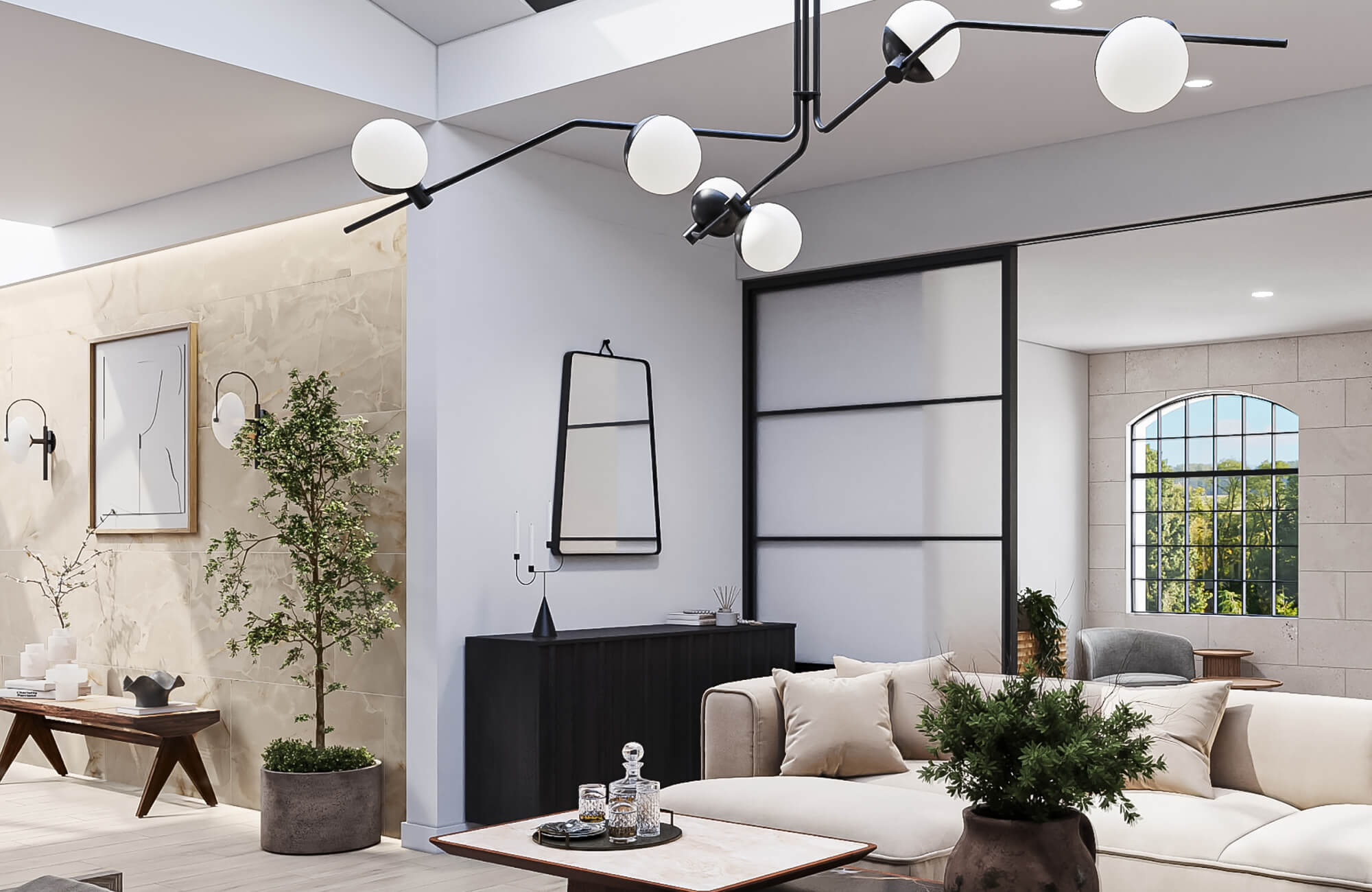Lighting isn’t just about visibility; it’s one of the most powerful tools in shaping how a room looks and feels. The right fixture can complement your design style, highlight architectural features, and create the perfect atmosphere for daily living. Yet with so many styles, finishes, and functions to choose from, finding the right one can feel overwhelming.
This guide breaks down how to choose lighting that fits your interior style, whether you're working with modern minimalism, traditional charm, or anything in between. With the right balance of form and function, your lighting can feel just as intentional as the rest of your space.
Why Lighting Should Align With Your Interior Style
Lighting plays a bigger role in interior design than most people realize. It doesn’t just illuminate, it sets the mood, supports how the space is used, and helps tie everything together. When lighting aligns with your interior style, the room feels more cohesive and grounded. It becomes easier to create a space that looks polished and feels just right.
Also, choosing fixtures that reflect your overall aesthetic adds a sense of thoughtfulness to the design. It shows intention, not just in how the space functions, but in how it speaks to your personal style. When your lighting and decor are in sync, the entire space tends to feel more complete, comfortable, functional, and well put-together.

Modern and Minimalist Interiors
Modern and minimalist interiors thrive on clarity, restraint, and thoughtful function. Lighting in these spaces should follow the same philosophy—every piece has a purpose, and nothing feels excessive. When chosen well, modern fixtures don’t compete for attention but instead bring quiet structure and balance to the room. The right lights support clean design without overwhelming the space.
Flush Mounts
Flush mounts are ideal for keeping things simple without sacrificing style. They sit close to the ceiling, which helps maintain a clean vertical line that works well in minimalist settings. Their low-profile form is especially helpful in spaces with lower ceilings or where you want to avoid visual clutter. Most come in matte or brushed finishes that suit modern palettes.
What makes them effective is their ability to provide general illumination while visually stepping back. They blend into the background and support the room’s architecture rather than defining it. For minimalist spaces, this kind of lighting adds clarity without complication. It’s one of those subtle touches that make everything feel more pulled together.
Linear Lights
Linear fixtures are a great match for modern spaces because they echo the simplicity of the overall design. They provide a sleek, continuous line of light that fits naturally over desks, kitchen counters, or dining tables. These fixtures are often chosen for their function, but their structure adds an understated sense of rhythm too. The shape alone complements modern geometry.
Beyond their shape, linear lights are appreciated for their consistency. They distribute light evenly, which suits a room where uniformity is key. You’ll often find them in spaces that prioritize calm and order. They’re not flashy, but they quietly anchor the room with just the right amount of presence.
Picture Lights
Minimalist spaces often feature a curated selection of art or decor, and picture lights are a smart way to highlight those choices without disrupting the clean feel. These fixtures tend to have a narrow profile and a neutral finish, letting them accentuate rather than compete with what’s on display. They help bring attention to the details you want to showcase. In many cases, they feel like a continuation of the frame itself.
The goal here isn’t to dramatize the wall, it’s to support it. Picture lights in minimalist interiors should be almost invisible until they’re needed. They serve the dual role of adding soft lighting and refining visual focus. When chosen with care, they become a subtle detail that reinforces the room’s calm, intentional design.

Traditional and Classic Spaces
Classic interiors are all about timeless charm and quiet elegance. Whether you're working with crown molding, antique furniture, or warm wood finishes, the lighting you choose should echo that same sense of tradition. It’s not about keeping things old-fashioned; it’s about choosing fixtures that complement the grace and detail already present in the room.
Chandeliers
Few fixtures feel as naturally suited to traditional interiors as chandeliers. Their presence alone adds height, structure, and a touch of formality, especially in grand areas like dining rooms, foyers, or even spacious bathrooms. Tiered silhouettes and candle-style arms create symmetry and elegance, reinforcing the calm, balanced nature of a classic design. They also help center the room, drawing the eye upward without overpowering the rest of the decor.
When selecting finishes, go for aged brass, antique bronze, or weathered gold tones, something with richness and history behind it. Our Robbins Pendant in Aged Brass, as seen in the image above, is a great example of a refined, warm-toned fixture that fits beautifully into a traditional setting without overwhelming the space. A chandelier in this kind of setting doesn’t need to be extravagant; it just needs to feel like it belongs, adding warmth and refinement in a way only traditional lighting can.
Sconces
Wall sconces bring both function and decoration to traditional spaces. Their sculpted designs and soft, directional light are perfect for framing mirrors, accenting hallway walls, or adding gentle ambiance to reading corners. Candle-shaped bulbs, curved arms, and fluted details help them blend in with classic decor without calling too much attention to themselves. They’re a small detail that can make a big visual difference.
Also, sconces allow for subtle layering, which is key in creating a cozy, well-lit space. Use them alongside chandeliers or table lamps to distribute light more evenly throughout the room. Choose warm-toned finishes like burnished brass or bronze that naturally age with grace. These fixtures don’t just light up a room; they help shape its entire mood.
Picture Lights
In a space filled with classic elements, picture lights feel like the final stroke of a well-painted canvas. They provide just the right amount of focused light to showcase framed artwork, decorative molding, or vintage mirrors without overwhelming them. Their long, slender forms and soft glow add polish while drawing attention to the pieces you’ve thoughtfully chosen to display.
Picture lights also support the room’s overall balance. For instance, above a fireplace or within a gallery wall, they help anchor the space visually. Choose finishes like brushed gold or antique brass that complement ornate frames or traditional furniture. They’re not flashy, but in traditional design, it’s often the quietest elements that carry the most weight.

Transitional and Contemporary Spaces
Transitional spaces strike a balance between traditional warmth and modern simplicity, making them incredibly versatile. The lighting in these interiors should reflect that same blend—clean, structured, and welcoming, without being overly ornate or overly minimal.
Semi-Flush Mounts
Semi-flush mounts are a reliable go-to for transitional rooms because they provide a subtle presence without overwhelming the ceiling line. These fixtures hang just slightly below the ceiling, which adds a bit more dimension than flush mounts while still keeping things tailored. They’re especially useful in areas like hallways, bedrooms, or home offices where you want general lighting that doesn’t dominate the space. For example, a brushed nickel fixture with a soft linen diffuser feels modern but still familiar.
They also offer a nice bridge between eras, something with a gentle curve or mixed finish can echo both traditional detailing and modern restraint. This makes them great for tying together rooms that blend multiple furniture styles. Plus, their modest drop gives the room more breathing room while still adding character. It’s a small design move that makes a space feel more considered.
Drum Shades
Drum shades are a staple in transitional design because they’re clean and structured without feeling cold or stark. Their round, fabric-covered form softens the look of a room while offering a pleasing silhouette that suits ceiling lights, sconces, or table lamps. For instance, a white drum chandelier over a wood dining table can feel classic and modern all at once. It’s the kind of fixture that works quietly in the background while still elevating the space.
What makes drum shades especially versatile is their adaptability. They come in neutral colors and varied textures, which makes them easy to pair with both bold and understated rooms. They also help diffuse light more evenly, giving the space a calm, ambient glow. In transitional interiors, this soft illumination helps tie everything together gently and effectively.
Pendant Lighting
Pendant lights work well in transitional spaces because they offer structure and flexibility. Their scale makes them easy to use as focal points, especially over kitchen islands or vanities, without feeling too heavy. Look for simple shapes in warm finishes, like a clear glass globe with brass accents, for a mix of traditional and modern character. These fixtures often add rhythm to a space as well, especially when hung in pairs or trios.
Also, pendant lighting allows you to play with contrast without disrupting the flow of the room. For example, a dark metal pendant in a light-colored space can provide just enough edge to keep things interesting. Our Barnes 9" Pendant in Aged Antique Distressed Bronze, as seen above, is a great example; its form adds personality without overwhelming the design. The key is balance, picking fixtures that feel intentional and grounded in the room’s broader story.

Coastal and Relaxed Interiors
Coastal and relaxed interiors thrive on calm, comfort, and natural flow. Lighting in these spaces should feel light, airy, and effortless, something that complements soft textures, breezy color palettes, and casual elegance. Think pieces that bring warmth without weight and help the room feel open and lived-in.
Woven or Rattan Pendants
Woven pendants are a staple in coastal-inspired spaces because they instantly add texture and an organic feel. Materials like rattan, seagrass, or cane create visual warmth while keeping the look casual and breezy. For instance, a rattan pendant over a breakfast nook adds just the right amount of character without overpowering the setting. These fixtures feel handmade and tactile, which works beautifully in interiors focused on ease and comfort.
They also soften the light in a way that suits relaxed environments. The weave creates shadows and dimension that play nicely against white walls or natural wood. Paired with linen curtains, jute rugs, or light oak furniture, they help complete the layered, earthy look. It’s a detail that makes the whole room feel more grounded and inviting.
Our Santos Pendant in Vintage Gold Leaf, as seen above, adds an artisanal twist to this style with its handwoven strands of wood beads and softly patinated metallic finish. Its tall, tapered silhouette and radiant gold chain make it ideal for kitchens and dining spaces that lean earthy yet refined.
White or Soft Pastel Fixtures
White or pastel-toned fixtures blend effortlessly into coastal and casual spaces. These softer hues don’t call attention to themselves, but instead enhance the openness and lightness of the room. For example, a pale blue sconce or white ceramic table lamp can feel both fresh and timeless. They work especially well when the surrounding palette is filled with sun-washed neutrals and soft fabrics.
Also, pastel and white finishes help maintain a sense of visual quiet. They reflect light beautifully and keep the space feeling uncluttered and clean. This makes them ideal for bedrooms, bathrooms, or entryways where you want a calm, welcoming vibe. In coastal interiors, these fixtures feel like a natural extension of the color story.
How to Balance Function and Style in Lighting
Great lighting doesn’t just look good; it also needs to work well for how you use the space. The key is finding fixtures that blend practical needs with your overall aesthetic. For instance, a sculptural pendant might set the tone in a dining area, but if it casts too little light over the table, it falls short functionally. It's important to ask: Does this light do its job, and does it fit the room visually, too?
Start by thinking about the type of light each area needs. Task lighting, like vanity sconces or under-cabinet strips, should be clear and focused, while ambient lighting can be softer and more diffused. Also, the style of the fixture should feel in sync with your decor, not forced or overly trendy. A clean-lined sconce in matte black, for example, can provide great task lighting and complement a contemporary bathroom without stealing attention.
Layering is another way to bring function and style together. Using a combination of overhead lights, wall fixtures, and accent pieces helps you adjust brightness and mood throughout the day. This approach also gives you room to mix subtle statement pieces with more understated essentials, so your lighting feels intentional from every angle. When style and utility are both considered, lighting becomes one of the most valuable design tools in any room.
Common Lighting Mistakes That Disrupt Interior Harmony
Even the most beautifully designed room can feel slightly off when the lighting isn’t quite right. One common issue is ignoring scale, using a fixture that's too small for a large space or too large for a compact room. For instance, a tiny flush mount in a vaulted foyer may feel lost, while an oversized chandelier in a low-ceilinged hallway can quickly overwhelm. The key is choosing lighting that suits the room’s proportions so everything feels balanced.
Another mistake is mixing too many competing styles or finishes without intention. While contrast can work well, it needs to feel cohesive; pairing a sleek chrome pendant with ornate bronze hardware can disrupt the flow if nothing ties them together. Also, relying on a single light source can leave parts of the room feeling dim or overly shadowed. Layering ambient, task, and accent lighting helps create depth and flexibility, making the space more functional and visually grounded.
Finally, don’t overlook consistency in color temperature. Mixing cool white bulbs with warm yellow ones can cause an uneven, disjointed atmosphere, even if your fixtures match. Aim for a unified lighting tone throughout each space to maintain a sense of calm and continuity. Lighting should support your design choices, not compete with them—when it all works together, the room just feels right.
Let Your Lighting Reflect Your Style
Choosing lighting fixtures that truly match your interior style takes more than just picking something that looks good—it’s about understanding how each piece fits into the bigger picture. From classic sconces to sculptural pendants, the right lighting can quietly echo your home’s personality while also improving its function. Whether you're drawn to coastal ease, traditional elegance, or modern simplicity, your lighting should work hand-in-hand with your space’s layout, materials, and mood.
Lighting is one of those elements that, when chosen well, can pull a room together almost effortlessly. If you need help selecting the perfect fixtures or want expert input on your overall design plan, please contact us to explore our personalized design services and bring your vision to life.










